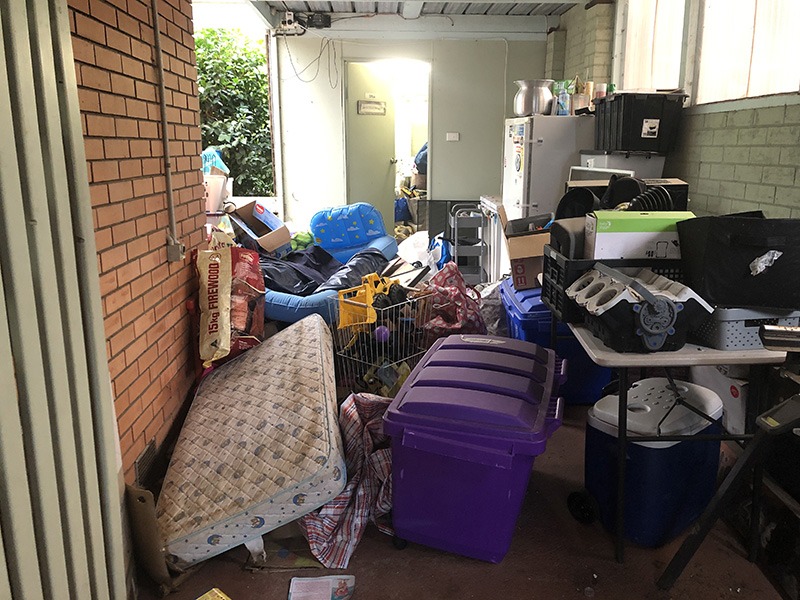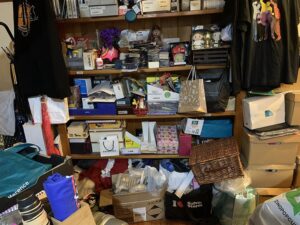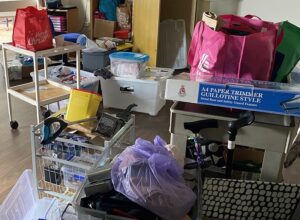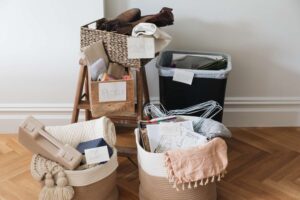
“How do I start decluttering?” I hear you ask. Perhaps you have watched Marie Kondo and The Home Edit on Netflix and you want to transform your home. You want to be surrounded by bare surfaces, organised cupboards and room to think and breathe.
How do I start decluttering? Steps
1. Put on some music or a podcast if you like. There are lots of decluttering podcasts if you want some related inspiration. Do a search, but my favourite is any interview with Peter Walsh. How do I start decluttering? You have started!
2. Start with some easy, high-reward tasks to gain momentum. Declutter the floor. Put dirty washing in the machine, dishes in the dishwasher and turn them on. Take out the rubbish and recycling. Fold laundry and put it away. Maybe there is other big stuff you can remove / donate / arrange a hard rubbish collection for.
3. Next, choose a space to focus on. I like the kitchen because I cook a lot, so there is plenty of time and stress to be saved from having it in order. Even non-cooks access the kitchen cupboards several times a day. Also, the kitchen is a functional space with fewer sentimental items. This makes the decluttering process fairly straightforward. If the entire kitchen is overwhelming, how about the pantry or fridge? Or even a drawer. Pop into the bedroom, put on some music and declutter the sock drawer. Start small and the rest can follow.
4. Take everything out of your chosen area and pile it on your bench or floor. Taking out every item rather than just plucking out what you don’t want means you have to make a conscious decision on every item before you return it. As you go, roughly group items together in categories that make sense. Baking ingredients, cereals, tea towels, pens, stirring implements. Categories are important. But don’t overthink it, broad categories are best when you are starting.
5. Grab the rubbish bin and four boxes or bags labelled (1) Move, (2) Donate, (3) Sell and (4) Keep. Labelling them helps tremendously. Reading labels is easier than thinking, therefore conserves your mental energy.
6. Put expired food and broken implements straight in the rubbish bin. Keep weeding as you go.
The Move box is for things that belong in other rooms.
The Donate box is for items of some value that you don’t need.
The Sell box if you can justify one, is for items and appliances which could be worth listing online or included in a garage sale.
The honourable Keep box is for items which will be returning to the valuable real estate that is your kitchen or your chosen area.
7. Wipe the heck out of those shelves or drawers. Goodbye spilled sauces, oily patches, dust and crumbs.
8. Put your Keep items back in their sensible categories, considering what is in high rotation. Do you bake every day, or only at Christmas? Does your family eat a lot of cereal? Put the high-volume items in the easy-to-access part of your setup. This is generally between hip and eye level or where ever is easiest to reach. Occasional or niche items can be on top shelves, and heavy items on bottom shelves for ease and safety of retrieval. And keep like with like.
9. Make sure you have room for everything, plus a bit extra. If it’s too crammed, you can’t see all the contents. Feel free to declutter more.
10. Label what ever you can. Trust me, it helps long term.
11. Stand back and admire your masterpiece.
12. Take all your Move items to their appropriate rooms and put them away. Don’t go down rabbit holes and get distracted trying to declutter every area you touch or you’ll burn out. Just put them vaguely away and you can come back and declutter each area properly later.
13. Put your Donate items in the car for the charity shop, or list them free online. There are lots of options for donation.
14. List your Sell items online. If this all seems too laborious, just donate them. No point making aspirational piles of sales you will never get around to. Your space and time is money too.
15. Choose another space to declutter. No more mumbling to yourself “how do I start decluttering?”, because you are now on your way to organised bliss.
How do I start decluttering? More tips
– Be realistic about your space and your items. Remove unnecessary household items. If you only use an appliance very rarely, perhaps you can give it away and make do with what you have. Single-use items like pie makers, corn poppers and apple corers take up cheeky room without giving much in return. Your space and mental energy is worth more than the 10 minutes per year these kinds of things might save you.
– Shelves may need to be adjusted depending the height of what you are storing. Pick the tallest item, adjust height and work from there.
– Deep corners can be made more functional by Lazy Susans which are available at Kmart, Ikea and online.
– The stacking of cans, jars or bathroom items can be made easier with small wire shelves called risers.
– Group similar items in wire baskets or plastic tubs. You might already have some unused Tupperware fit for this purpose.
– Speaking of Tupperware, I store mine with lids on. It’s a space-hungry method but pays its way in time savings. No more searching for lids!
– Longer term, stay tidy so you don’t have to revisit the problem. Put things away in their designated spots immediately. Reseal packs to avoid spillage (I just use elastic bands). Check your supplies before you head to the supermarket. Stop. Buying. Crap. Little habits help. If you don’t wash dishes regularly they pile up and clutter your space. If you don’t take out the recycling, empty yoghurt containers end up on the bench.
– To go deeper, read about how to declutter clothes, pantries and sentimental items.
– For help making decisions, check this post.






























